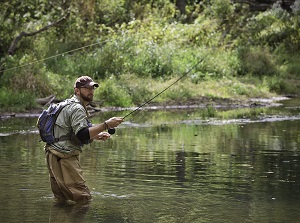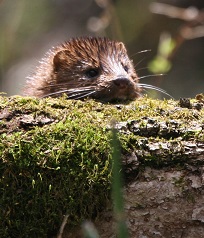 Birds, trout, school kids, paddlers. That’s just the start of the list of those that benefit from the Root River watershed.
Birds, trout, school kids, paddlers. That’s just the start of the list of those that benefit from the Root River watershed.

photo by Steve Smith
And now 86 acres of forest, wetlands and open water are protected forever by Root River landowners Monica and Geoff Griffin, and the Minnesota Land Trust.
“If I could choose a single spot for a conservation easement,” mused Program Manager Nick Bancks, “this tract of land would be in my top five for sure.”
Location Location Location

Photo credit: Dan Kauffman
The Land Trust likes to protect lands that are connected to other conservation easements, state or federal land, or other open spaces like youth camps. Similar to putting an addition on your kitchen, the conservation easement adds useful space that almost seems to multiply the utility of the existing space.
This newly protected project on the Root River is all that and more. Located just two miles north of Lanesboro in southeastern Minnesota, the land is located directly next to the non-profit Eagle Bluff Environmental Learning Center. In fact, the Griffins support educational programming at Eagle Bluff by providing access to the Root River, a state-designated water recreation trail.
The Griffin’s property is also directly adjacent to a 900-acre management unit of the Richard J. Dorer Memorial Hardwood State Forest and it’s within a five-mile radius of two other Minnesota Land Trust conservation easements as well as a DNR Aquatic Management Area.
By protecting large swaths of land, certain species that require a large range, such as the red-shouldered hawk pictured above, continue to thrive.
On top of all that, the land is within the Audubon Society’s Blufflands-Root River Important Bird Area, providing an important stopover for migrators in a landscape that’s becoming less and less hospitable.
A River Runs Through It

photo by Fitz Fitzgerald
The Root River, while beautiful, is listed as an impaired river because it has high turbidity—that means it’s dirty, which is a problem if you’re a trout.
 Trout need cold, high quality water and a conservation easement helps with both of those things.
Trout need cold, high quality water and a conservation easement helps with both of those things.
First, a natural, undeveloped shoreline lets far less runoff into the water. And second, a preserved upland forest, maintains the cool temperature of the water.
The beneficiaries go beyond fish. The Root River Watershed area is located in the Driftless Area, a landscape rich in sinkholes, caves, and springs. These fractures in the soluble bedrock create direct conduits to the groundwater making it more susceptible to pollution. However, when the water flows over forested land, contaminants are filtered out much more effectively.
The Griffin’s conservation easement, which is held into perpetuity by the Land Trust, prohibits future industrial, residential and agricultural development.

 Funding was provided by members of the Minnesota Land Trust and the Outdoor Heritage Fund for the Root River Protection and Restoration Program that is jointly managed by the Minnesota Land Trust, The Nature Conservancy and the Minnesota DNR.
Funding was provided by members of the Minnesota Land Trust and the Outdoor Heritage Fund for the Root River Protection and Restoration Program that is jointly managed by the Minnesota Land Trust, The Nature Conservancy and the Minnesota DNR.



